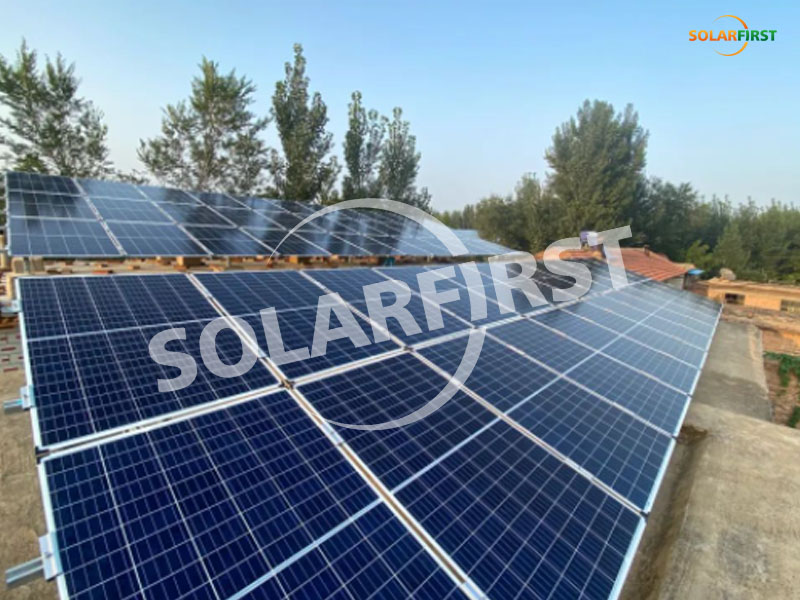Tel: +86 592 5211 388 / Email: info@esolarfirst.com
Is your photovoltaic plant ready for summer?
Release time:
May 17,2022
The turn of spring and summer is a period of frequent severe convective weather, and the subsequent hot summer is accompanied by high temperatures, heavy rains and thunder, and the photovoltaic power station on the roof has undergone multiple tests. So, how should we take countermeasures to ensure the stable operation of photovoltaic power plants and ensure revenue?

For the high temperatures of the summer
1. Pay attention to cleaning and cleaning the obstructions on the power station, so that the components are in a state of ventilation and heat dissipation at all times.
2. Please clean the power station in the early morning or evening, and avoid the exposure to the sun and high temperature at noon and afternoon, because the sudden cooling will cause the temperature difference of the module glass plate, and there may be cracks on the plate surface. Therefore, it is necessary to choose early morning and evening when the temperature is low.
3. High temperature may cause the aging of the internal components of the inverter, so it is very important to ensure that the inverter has good ventilation and heat dissipation conditions. The inverter will basically be installed outdoors, and the inverter will be placed in a cool place away from direct sunlight during installation, such as the back of the module or under the eaves, and a cover plate will be installed for outdoor installation to fully ensure the ventilation and heat dissipation of the inverter.
For summer rainstorms
A large amount of rainwater will soak the cables and components, which will reduce the insulation performance, and if it is damaged, it will directly lead to the inability to generate electricity.
If your home has a pitched roof, it will have a strong drainage capacity, so don't worry; If it is a flat roof, the power station needs to be inspected frequently. Note: When inspecting and operating in rainy days, avoid freehand electrical operation, do not directly touch the inverter, components, cables and terminals with your hands, and wear rubber gloves and rubber boots to reduce the risk of electric shock.
Thunder and lightning in the summer
The lightning protection facilities of photovoltaic power stations should also be checked regularly. At this stage, the most effective and widespread lightning protection method is to connect the metal parts of electrical equipment to the earth. The grounding system consists of four parts: the grounding device, the grounding body, the lead-in wire, and the earth. Avoid overhauling electrical equipment and wiring with bare hands, wear insulated rubber gloves, beware of the risk of electric shock, and take measures to prevent high temperatures, heavy rain, typhoons, and lightning strikes.
The weather is unpredictable, and increasing the inspection and operation and maintenance of the power station can effectively avoid failures and even accidents, and ensure the power generation income of the power station. You can simply perform O&M on a typical basis, or you can hand over the power station to professional O&M engineers for inspection and maintenance.
Solar First Energy Technology
Performance & Innovation, Customer Focus, Respect Nature & Love Human, Spirit of Contract
CONTACT INFORMATION
Add: 23rd Floor, Building F14, Software Park Phase III, Jimei District, Xiamen, China
Tel: +86 592 5211 388
Mobile: +86 189 5920 8686
Email: info@esolarfirst.com

OFFICIAL WECHAT
All Rights Reserved © 2024 Solar First Energy Technology Co., Ltd.
Cookie
Our website uses cookies and similar technologies to personalize the advertising shown to you and to help you get the best experience on our website. For more information, see our Privacy & Cookie Policy
Cookie
Our website uses cookies and similar technologies to personalize the advertising shown to you and to help you get the best experience on our website. For more information, see our Privacy & Cookie Policy
These cookies are necessary for basic functions such as payment. Standard cookies cannot be turned off and do not store any of your information.
These cookies collect information, such as how many people are using our site or which pages are popular, to help us improve the customer experience. Turning these cookies off will mean we can't collect information to improve your experience.
These cookies enable the website to provide enhanced functionality and personalization. They may be set by us or by third-party providers whose services we have added to our pages. If you do not allow these cookies, some or all of these services may not function properly.
These cookies help us understand what you are interested in so that we can show you relevant advertising on other websites. Turning these cookies off will mean we are unable to show you any personalized advertising.

